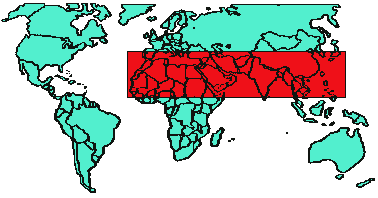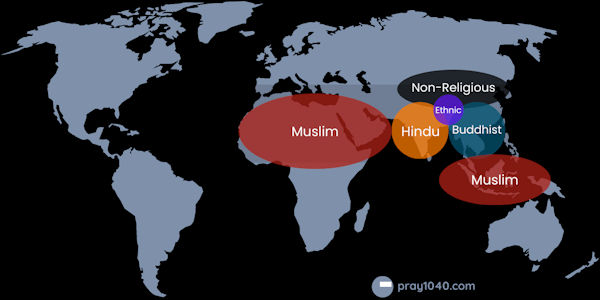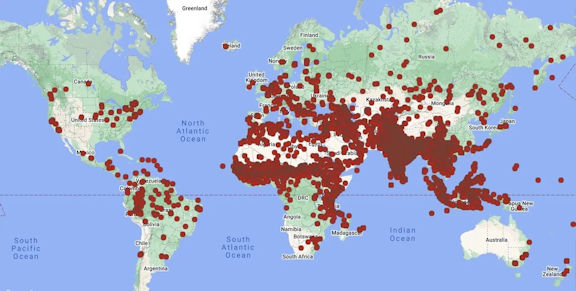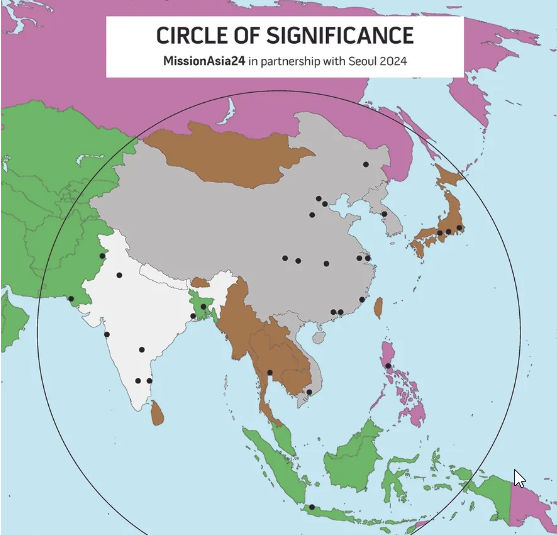
TL;DR
Millions of people in the 10/40 Window, who have limited to no access to the Gospel, pose a significant challenge to world evangelization efforts. Of the 55 least evangelized countries, 97% of their total population lives within the 10/40 Window. Almost 9 out of 10 people in the 10/40 Window remain outside the reach of current evangelistic efforts. The page includes three other world maps that use different ways of visualizing where there are unreached people groups.

"We need another surge into the darkness! May God give us the necessary urgency and passion." -- Dale Butler, Nazarene Bible College student
Pray10/40 maps | Circle of Significance
Most of the people groups unreached by the gospel live within a rectangular area stretching across northern Africa and into southern Asia. Christian missions strategist Luis Bush started calling this rectangular area or band"the 10/40 window." He used that easy-to-remember name because it covers Africa and Asia from 10 degrees latitude north of the equator to 40 degrees latitude north of the equator.1
World evangelism statistics: Of the 55 least evangelized countries, 97% of their population lives within the 10/40 Window. Unless something changes, huge numbers of these unreached people groups will go out into eternity never having heard the Gospel. Why? Well, researcher Justin Long has estimated that only about 10% of the global missionary force is working there. One reason is that in many 10/40 Window countries, open evangelism is difficult and even impossible because of governmental restrictions. Such places have sometimes been called creative access areas.
Many factors contribute to the spiritual need in the 10/40 Window, including poverty, political instability, and the influence of other religions. Islam, Hinduism, and Buddhism are the dominant religions in many of these countries, and Christianity is often viewed with suspicion or outright hostility. Despite these challenges, many denominations, missions boards, and individuals are working to spread the gospel and meet the physical and spiritual needs of the people in the 10/40 Window.
The 10/40 Window represents both an enormous challenge and an opportunity for the global church as it seeks to share the love of Christ with those who have never heard.
1Lines of latitude run in an east-west direction around the Earth. The latitude lines and north-south longitude lines make it possible to precisely mark every place on Earth. Although these are only imaginary lines, they appear on maps and globes as if they actually existed. The equator is the "0" latitude line with all of the other latitude lines labeled in terms of "degrees north" and "degrees south." The use of latitude/longitude lines began more than two thousand years ago.
Working on a school report about missions? Here are some facts to use.
The statistics of the numbers of non-Christians can be staggering [ fate of the unevangelized ]
"I will praise you among the nations, O Lord" -- Psalm 18:49
The 10/40 Window concept is one way of looking at the task yet to be done in world evangelism. Another way is to focus on the unreached people groups wherever they may be in the world. Mission organizations have historically talked about their outreach in terms of the nations in which they are working. Using that lens, here are the sovereign states in the 10/40 window:
As a quick bit of research will show, there are huge variations economically, culturally, politically, religiously, ancestral heritage, population size, and climate-wise. The only two things they all have in common are (1) geographic location and (2) substantial percentages of unbelievers. They all are located in a rectangular area from 10 degrees latitude north of the equator to 40 degrees latitude north of the equator. Africa and Southern Europe form the western end of the rectangle, and Asia forms the eastern end of it.
Afghanistan Algeria Bahrain Bangladesh Benin Bhutan Burkina Faso Cambodia Chad China Cyprus Djibouti Egypt Eritrea Ethiopia Gambia Gibraltar Greece Guinea Guinea-Bissau India Iran Iraq Israel Japan Jordan Korea (North and South) Kuwait Laos Lebanon Libya Macau Mali Malta Mauritania Morocco Myanmar (Burma) Nepalj Niger Oman Pakistan Philippines Portugal Qatar Saudi Arabia Senegal Sudan Syria Taiwan Tajikistan Thailand Tunisia Turkey Turkmenistan United Arab Emirates Vietnam Western Sahara Yemen
A few decades ago missiologist Luis Bush coined the phrase "10/40 Window." He did that to focus attention on a specific area of the world where millions have little or no access to the Gospel.
Bush asked believers to draw an imaginary rectangle on the globe going from 10 degrees north of the equator to 40 degrees north of the equator, stretching from westernmost Africa to just east of Japan. Pointing to that imaginary oblong "window," Bush pleaded with the Church to mobilize prayer, people, and resources to evangelize and disciple people in all of the unreached and least-reached people groups in the northern half of Africa, the Middle East, and the areas once ruled by the ancient Babylonian and Persian empires as well as much of Asia including India and China.
The statistics from that 10/40 Window can be staggering. Two-thirds of all people on Earth live in that rectangular area. Almost all of the world's 55 least-evangelized countries are in the 10/40 Window. Half of the world's least-evangelized large cities are in the 10/40 Window. The majority of the world's Muslims, Hindus, Buddhists, and Sikhs live in the 10/40 Window. Sadly, the 10/40 Window is also home to 8 out of 10 of the poorest of the earth's poor.
Many areas in the 10/40 Window are places that Nazarene World Mission director Verne Ward describes as "where the Church is not yet." With just 10% of the current global Christian missionary force working there, that situation is not changing very rapidly. Unfortunately, almost 9 out of 10 of the people living in the 10/40 Window today remain outside the reach of current evangelistic efforts.
In several 10/40 Window countries, Christians suffer physical persecution and even death for their faith. Due to anti-Christianity hostility and stringent government restrictions, many missionaries in the 10/40 Window have become creative in evangelizing and discipling people. Many of these countries will not give visas to religious workers. So they have been labeled Creative Access areas. Patrick Johnstone has called this area the "resistant belt."
Drawing attention to the evangelistic task yet to be done, the visually dramatic 10/40 Window concept has inspired many to offer themselves for missionary service in some of the world's most difficult and challenging places.
To be sure, the countries of the 10/40 Window are not the only places that need missionaries. So, this is not a call to remove missionaries from other areas of the world and send them all to the 10/40 Window. The 10/40 Window countries are not the only ones with sinners needing missionaries to go across cultural and language barriers to tell them about God's redeeming grace. However, the 10/40 Window does contain huge blocs of people who, by any definition, are today unreached and unevangelized.
We must pray that God will call more and more laborers into the countries in the 10/40 Window harvest field!
Another way of looking at where the Gospel message has not penetrated very well is a map by Pray10/40.com which shows concentrations of unreached people groups.

The Pray 10/40 group has also created a world map on which dots have been placed to show the location of unreached people groups.

Image credit: https://pray1040.com/unreached-people-groups-the-ultimate-guide/
-- Howard Culbertson, hculbert@snu.edu
This blog post on a key issue in world missions is one of 12 articles in the "Mission briefing" series published in Engage, a monthly online magazine produced by the Church of the Nazarene.
Note about Earth's latitude lines: The latitude lines, such as the "10" and "40" in 10/40, are also called "parallels." They are imaginary lines that run along the Earth's surface parallel to the equator. They are common ways to signal the distance north or south of the equator. Here is why they are expressed in degrees: Imagine drawing a line from Earth’s center to a point on the equator, and another line from Earth’s center to your location. The angle between those two lines is the degrees of latitude.
The equator itself is 0 degrees latitude. As you move north from the equator, the latitude values increase all the way to 90 degrees at the North Pole. Similarly, as you move south from the equator, latitude values increase up to 90 degrees at the South Pole. That means there are a total of 180 lines of latitude. The lines are evenly spaced and are typically depicted on maps and globes to aid in navigation and geographic reference.
Some mission strategists have divided the world's population into three groups they call World A, World B, and World C
These "worlds" are not geographic areas but rather segments of the world's population.
U.S. State Department reports on International Religious Freedom
"God forgive us when we cheapen the sacrifice of those who have gone before us when we claim we are being persecuted for our faith in the U.S." — Louise Smith, Nazarene Bible College student
"Let us not become weary in doing good, for at the proper time we will reap a harvest if we do not give up." -- Galatians 6:9
Here are five things you can start doing today. to reach unreached people groups
"This gospel of the kingdom will be preached in the whole world as a testimony to all nations" -- Matthew 24:14 (more on Matthew 24:14
Missional Digerati, a community of thinkers, designers and developers committed to exploiting breakthroughs in technology in order to advance the pace of reaching every person on earth with the good news of Jesus Christ.
One more way of looking at where missionaries are needed is with "The Circle of Significance" from City Vision. Inside that circle, which e ncompasses much of Asia, live 99% of all the world's Hindus, 99% of all the world's Taoists, and 98% of all Buddhists. That circle, which has a radius of 2000 miles (the distance from New York City to Albuquerque, NM), is home to over 4 billion people, most of them unreached by the Gospel.
 ,
, -- Howard Culbertson,
-
Insight: Geographic and demographic prioritization
The 10/40 Window highlights the region between 10 and 40 degrees north latitude, spanning parts of North Africa, the Middle East, and Asia. This area contains the largest concentration of unreached people groups and the fewest Christians.
The insight this image offers is the need for strategic focus on regions of greatest spiritual need. It emphasizes the importance of directing mission resources, personnel, and prayer efforts toward regions with limited gospel access, where billions remain unreached.
Insight: Population-centric prioritization
This image centers on a circle (roughly 4,000 kilometers in radius) over Asia. It includes countries such as India, China, Indonesia, Bangladesh, and Pakistan. Though it covers only a fraction of the Earth's surface, it contains more than half of the world’s population.
The insight here is the call to prioritize people over land area, recognizing that the densest populations hold the greatest potential for spiritual impact. It challenges mission efforts to concentrate on regions where the sheer number of people makes outreach exponentially significant.
Insight: Spiritual access categorization
This model divides the world into three groups:The key insight is the need for differentiated missions strategies. It underscores the importance of:
- World A – Unreached: No significant access to the gospel.
- World B – Evangelized but not yet converted: Some gospel access but still needing widespread discipleship.
- World C – Christianized: Significant Christian presence with churches established.,/li>
This image helps missionaries and churches allocate efforts wisely based on the spiritual needs of each "world."
- Pioneer evangelism in World A
- Discipleship and church strengthening in World B
- Mobilizing and sending missionaries from World C to the least-reached areas.
Together, these images can help us strategically fulfill the Great Commission through prioritizing geographic, demographic, and spiritual elements.
R - Ripe fields are waiting, golden with grain.
E - Eagerly pray for more hands in His name.
A - All are called, but few will go.
P - Prepare the way—His love must show.
E - Every soul is precious and dear.
R - Reach them now, the time is near.
S - Send forth workers, strong and true!
Like acrostics? Here are more of them